
The Treaty of Aigun was an 1858 treaty between the Russian Empire and Yishan, official of the Qing dynasty of China. It established much of the modern border between the Russian Far East and China by ceding much of Manchuria, now known as Northeast China. Negotiations began after China was threatened with war on a second front by Governor-General of the Far East Nikolay Muraviev when China was suppressing the Taiping Rebellion. It reversed the Treaty of Nerchinsk (1689) by transferring the land between the Stanovoy Range and the Amur River from the Qing dynasty to the Russian Empire. Russia received over 600,000 square kilometers (231,660 sq mi) of what became known as Outer Manchuria. While the Qing government initially refused to recognize the validity of the treaty, the Russian gains under the Treaty of Aigun was affirmed as part of the 1860 Sino-Russian Convention of Peking.
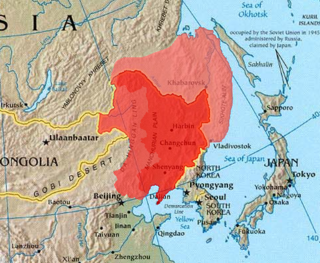
Outer Manchuria, sometimes called Russian Manchuria, refers to a region in Northeast Asia that is now part of the Russian Far East but historically formed part of Manchuria. While Manchuria now more normatively refers to Northeast China, it originally included areas consisting of Priamurye between the left bank of Amur River and the Stanovoy Range to the north, and Primorskaya which covered the area in the right bank of both Ussuri River and the lower Amur River to the Pacific Coast. The region was ruled by a series of Chinese dynasties and the Mongol Empire, but control of the area was ceded to the Russian Empire by the Qing China during the Amur Annexation in the 1858 Treaty of Aigun and 1860 Treaty of Peking, with the terms "Outer Manchuria" and "Russian Manchuria" arising after the Russian annexation. The same general area became known as Green Ukraine after a large number of settlers from Ukraine came to the region.

The Ussuri or Wusuli is a river that runs through Khabarovsk and Primorsky Krais, Russia and the southeast region of Northeast China. It rises in the Sikhote-Alin mountain range, flowing north and forming part of the Sino-Russian border, until it joins the Amur as a tributary to it near Khabarovsk. It is approximately 897 km (557 mi) long. The Ussuri drains the Ussuri basin, which covers 193,000 km2 (75,000 sq mi). Its waters come from rain (60%), snow (30–35%), and subterranean springs. The average discharge is 1,620 m3/s (57,000 cu ft/s), and the average elevation is 1,682 metres (5,518 ft).

Transbaikal, Trans-Baikal, Transbaikalia, or Dauria is a mountainous region to the east of or "beyond" (trans-) Lake Baikal in Far Eastern Russia.
The Nanai language is spoken by the Nanai people in Siberia, and to a much smaller extent in China's Heilongjiang province, where it is known as Hezhe. The language has about 1,400 speakers out of 17,000 ethnic Nanai, but most are also fluent in Russian or Chinese, and mostly use one of those languages for communication.

Plebejus is a genus of butterflies in the family Lycaenidae. Its species are found in the Palearctic and Nearctic realms.

Boloria is a brush-footed butterfly (Nymphalidae) genus. Clossiana is usually included with it nowadays, though some authors still consider it distinct and it seems to warrant recognition as a subgenus at least.

Simyra splendida is a moth of the family Noctuidae. It is found in central Asia, from China to Tibet, Mongolia, the Korean Peninsula, the Russian Far East, southern Kazakhstan and southern Siberia (Transbaikalia).

Heliothis ononis, the flax bollworm, is a moth of the family Noctuidae. The species was first described by Michael Denis and Ignaz Schiffermüller in 1775. It is found in China, Kazakhstan, central Asia, northern Mongolia (Khangai), the Russian Far East, the Korean Peninsula, southern European part of Russia, southern and central Europe, southern and eastern Siberia and Turkey. In North America it is found from south-central Manitoba west to British Columbia, north to the Northwest Territories and Yukon and Alaska and south to Colorado.

Melitaea arcesia, the blackvein fritillary, is a butterfly of the family Nymphalidae. It is found from southern Siberia and Transbaikalia to the Amur region, Mongolia and China. The habitat consists of steppe-clad slopes.

Melitaea centralasiae is a butterfly of the family Nymphalidae. It is found in eastern Russia and northern Mongolia.

Euphydryas sibirica is a butterfly of the family Nymphalidae. It is found in north-eastern Asia, where it is found in steppe or steppe-like meadows.
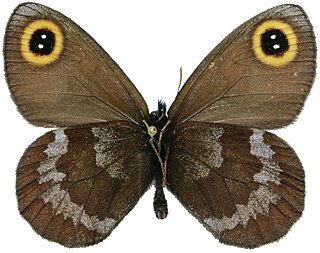
Erebia cyclopius is a species of butterfly of the subfamily Satyrinae in the family Nymphalidae. It is found through Siberia, northern Mongolia, northern China and North Korea. The habitat consists of forest edges, flowery meadows and sparse larch forests.
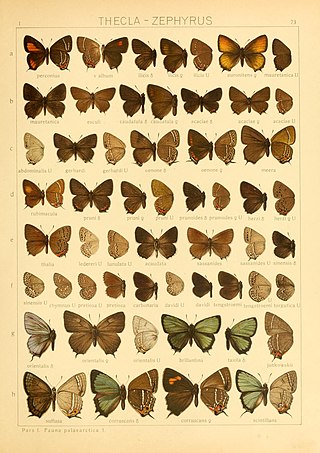
Satyrium prunoides is a butterfly of the family Lycaenidae. It was described by Otto Staudinger in 1887. It is found in the Russian Far East, Mongolia, north-eastern China and Korea.
Chelis kindermanni is a moth in the family Erebidae. It was described by Otto Staudinger in 1867. It is found in Russia, Mongolia and China.
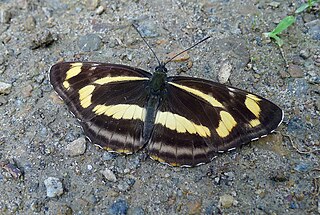
Aldania is a butterfly genus of the Limenitidinae. The genus is confined to the temperate East Palearctic. Aldania is closely related to Neptis.
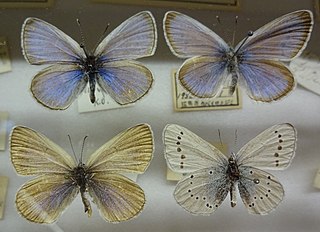
Glaucopsyche lycormas is a butterfly of the family Lycaenidae. It is found in the East Palearctic in Siberia, Mongolia, China, Korea and Japan.

Aricia chinensis is a small butterfly found in the East Palearctic that belongs to the lycaenids or blues family.
















